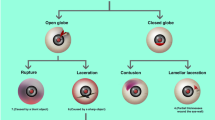Abstract
Purpose
To review the epidemiology of serious ocular trauma presenting to Kasr El Aini Hospital, Cairo University.
Methods
This is a prospective epidemiological and clinical study of ocular trauma patients admitted to Kasr El Aini hospital during a 6-month period; January–June 2000. Cases were analyzed with respect to: (1) demographics, (2) time, place and nature of trauma, (3) type of injury, (4) time to receive care, and (5) management and visual outcomes following primary repair.
Results
One hundred and fifty three eyes of 147 patients (six bilateral injuries) sustaining serious ocular injury requiring hospitalization were included during the study period. Eighty percent of ocular trauma occurred in men (P < 0.001 chi-square test) with an average age of 22 years (ranging from 2 months to 76 years). There were 123 (80.4%) open globe injuries and 30 (19.6%) closed globe injuries. Of the open globe injuries, 48 eyes (31.4% of all eyes) were ruptured globes and 75 eyes (49% of all eyes) were lacerated globes (37 intraocular foreign bodies, 35 penetrating injuries and three perforating injuries, that is 24%, 23%, and 2% respectively of all injured eyes). Of the closed globe injuries, 5.9% had hyphema (33% of all patients), 4% lamellar lacerations, and 2.5% vitreous hemorrhage with retinal detachment. Most of the injuries occurred (39.5%) and presented (36.7%) between 12:00–5:59 pm. Eighteen patients (12%) presented after 24 hours, and nine patients (6%) 1 week after the time of trauma. Presenting visual acuity in 123 patients (123 eyes) was as follows: 98 (80%), ten (8%) and 15 (12%) patients had poor, moderate and good visual acuity respectively. Ten eyes developed posttraumatic endophthalmitis (8% of open globe injuries). On leaving the hospital, 77.1% eyes had a visual acuity of less then 1/60 (poor), 3.9% were between 1/60 and 6/60 (moderate), and 19% were 6/36 and/or better (good). Fifty-two (35%) patients were lost in follow-up: at 1 month, 60%, 7% and 33% of the rest had poor, moderate and good visual acuity respectively.
Conclusion
The majority of ocular trauma in our population was due to assaultive injuries occurring mainly in males. Open globe injuries were more common than closed globe injuries, and globe lacerations were more common than ruptured globes. Open globe injuries, especially ruptured globes, had the worst visual outcomes. The initial visual acuity correlated well with the final visual acuity. Immediate and comprehensive medical care is mandatory for ocular trauma patients. Educating the public is essential if we wish to prevent eye injuries.





Similar content being viewed by others
References
Brinton GS, Aaberg TM, Reeser FH, Topping TM, Abrams GW (1982) Surgical results in ocular trauma involving the posterior segment. Am J Ophthalmol 93(3):271–278
De Juan E, Sternberg P, Michels RG (1983) Penetrating ocular injuries, types of injuries and visual results. Ophthalmology 90:1318–1322
Esmaeli B, Elner SG, Schork MA, Elner VM (1995) Visual outcome after penetrating trauma, a clinicopathological study. Ophthalmology 102:393–400
Groessl S, Nanda SK, Mieler WF (1993) Assault-related penetrating ocular injury. Am J Ophthalmol 116(1):26–33
Kim JH, Yang SJ, Kim DS, Kim JG, Yoon YH (2007) Fourteen-year review of open globe injuries in an urban Korean population. J Trauma 62(3):746–749
Kim JK, Kim JW, Lee J (1992) Clinical evaluation of penetration ocular injuries. J Korean Ophthalmol Soc 33:919–924
Kuhn F, Morris R, Witherspoon CD, Heimann K, Jeffers JB, Treister G (1996) A standardized classification of ocular trauma. Ophthalmology 103(2):240–243
Kuhn F, Morris R, Witherspoon CD, Heimann K, Jeffers JB, Treister G (1996) A standardized classification of ocular trauma. Graefes Arch Clin Exp Ophthalmol 234(6):399–403
May DR, Kuhn FP, Morris RE, et al. (2000) The epidemiology of serious eye injuries from the United States Eye Injury Registry. Graefes Arch Clin Exp Ophthalmol 238:153–157
McCarty CA, Fu CL, Taylor HR (1999) Epidemiology of ocular trauma in Australia. Ophthalmology 106:1847–1852
Negrel AD, Thylefors B (1998) The global impact of eye injuries. Ophthalmic Epidemiol 5:143–169
Pieramici DJ, MacCumber MW, Humayun MU, Marsh MJ, de Juan E Jr (1996) Open-globe injury. Update on types of injuries and visual results. Ophthalmology 103(11):1798–1803
Pieramici DJ, Au Eong KG, Sternberg P Jr, Marsh MJ (2003) The prognostic significance of a system for classifying mechanical injuries of the eye (globe) in open-globe injuries. J Trauma 54(4):750–754
Rahman I, Maino A, Devadason D, Leatherbarrow B (2006) Open globe injuries: factors predictive of poor outcome. Eye 20(12):1336–1341. Epub 2005 Sep 23
Rofail M, Lee GA, O’Rourke P (2006) Prognostic indicators for open globe injury. Clin Experiment Ophthalmol 34(8):783–786
Smith AR, O’Hagan SB, Gole GA (2006) Epidemiology of open- and closed-globe trauma Presenting to Cairns Base Hospital, Queensland. Clin Experiment Ophthalmol 34(3):252–259
Sternberg Jr P, de Juan Jr E, Michels RG, Auer C (1984) Multivariate analysis of prognostic factors in penetrating ocular injuries. Am J Ophthalmol 98(4):467–472
Thompson CG, Kumar N, Billson FA, Martin F (2002) The etiology of perforating ocular injuries in children. Br J Ophthalmol 86(8):920–922
Thylefors B (1992) Epidemiological patters of ocular trauma. Aust NZ Ophthalmol 20:95–98
Wong TY, Tielsch JM (1999) A population-based study on the incidence of severe ocular trauma in Singapore. Am J Ophthalmol 128:345–351
Zagelbaum BM, Tostanoski JR, Kerner DJ, Hersh PS (1993) Urban eye trauma. A one-year prospective study. Ophthalmology 100(6):851–856
Acknowledgment
No acknowledgment is disclosed. This work has not been sponsored by any institution.
Competing interest statement
The Authors have no financial or proprietary interest in any product mentioned in this paper.
Ethical approval
Approval for the study was obtained from the hospital’s ethical committee.
Author information
Authors and Affiliations
Corresponding author
Rights and permissions
About this article
Cite this article
Soliman, M.M., Macky, T.A. Pattern of ocular trauma in Egypt. Graefes Arch Clin Exp Ophthalmol 246, 205–212 (2008). https://doi.org/10.1007/s00417-007-0720-4
Received:
Revised:
Accepted:
Published:
Issue Date:
DOI: https://doi.org/10.1007/s00417-007-0720-4




